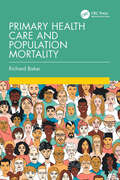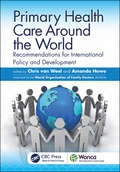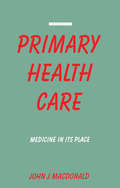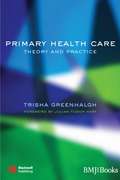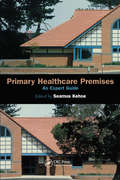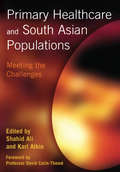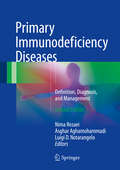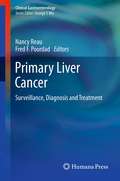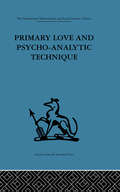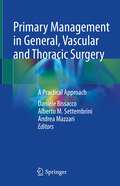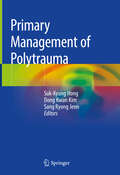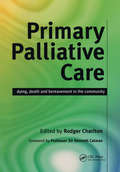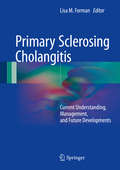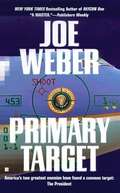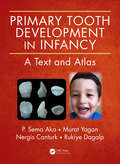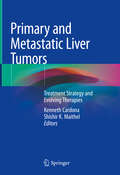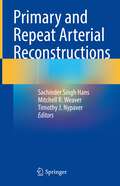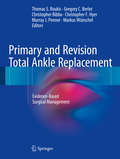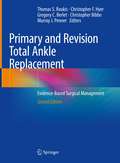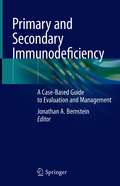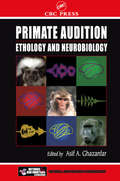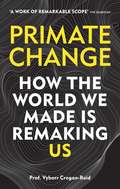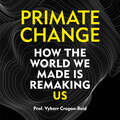- Table View
- List View
Primary Health Care and Population Mortality
by Richard BakerPopulation health management is being increasingly adopted by health systems yet the importance of primary health care in influencing population mortality and the mechanisms that explain it are not well understood. Too often, primary health care is regarded as a service for minor health problems and for managing access to secondary care. This limited view is no longer tenable and it is time to be much more ambitious about the place of primary health care in health systems worldwide. In delivering and planning health care and in re-building health systems after the pandemic, practitioners and policymakers in low-, middle- and high-income countries need evidence on how primary health care affects population mortality and practical advice to effect change. Primary Health Care and Population Mortality fulfils this need. Drawing on his long experience as both a practitioner and researcher, the author Richard Baker describes how primary health is crucial to the effect of health systems on population mortality, including its potential for reducing inequalities in mortality. This accessible new book will provide invaluable information to leaders in service development and delivery, academics in primary health care and those working within international organisations that are promoting primary health care for improving population health. It will also be of practical value to general practitioners, primary health care nurses and managers and public health staff.
Primary Health Care around the World: Recommendations for International Policy and Development (WONCA Family Medicine)
by Amanda Howe Chris Van WeelThis unique book is the first to bring together primary care experiences from around the world, with emphasis on non-Western regions. Utilising published articles that profile different countries’ primary health care, accompanied by expert commentaries, the book consolidates global primary health care information over the past decade. Profiling the different countries’ primary health care systems and their implementation of primary health care policy, as promoted by WHO and WONCA, the guide provides evidence of how countries and regions can introduce primary health care and family practice to improve their health care infrastructure and delivery. The book is essential reading for policy makers, health educators and academic leaders in primary care and students of global health and provides useful background for those entering or established in clinical family practice around the world.
Primary Health Care in Tanzania through a Health Systems Lens: A History of the Struggle for Universal Health Coverage
by Marcel Tanner Don De Savigny Maryam Amour Mackfallen Anasel Rutasha Dadi Faisal Issa Mwandu Kini Jiyenze Godfrey Kacholi Antony Kapesa Leonard Katalambula Anosisye M. Kesale Stephen M. Kibusi Amani Kikula Erick Kitali George Kiwango Claud Kumalija Hadija Kweka Zarina Shamte Madabida Abel Makubi Innocent Mboya Romuald Mbwasi William Mfuko Chipole Mpelembe Gemini J. Mtei Oresto Michael Munishi Castory Munishi Elihuruma M. Nangawe Harrieth P. Ndumwa Frida N. Ngalesoni Jackline E. Ngowi Belinda J. Njiro William Reuben George M. Ruhago Bakari Salum Aifelo Sichalwe Nathanael Sirili Felix Sukums Bruno F. Sunguya Idda L. Swai Desderi Wengaa Chacha ManguRobust health care systems are paramount for the health, security, and prosperity of people and countries as a whole. This book provides for the first time a chronicle of the struggle for, and eventual success of, universal health coverage (UHC) in Tanzania. Beginning with an introduction to primary health care in the country, from its historical foundations to the major milestones of implementation, this book then considers stewardship of this important aspect of health systems over time. Written in a way to allow the application of lessons learned to other countries' contexts, this book covers: - Policy and governance issues such as leadership, human resources, and financing of health systems; - Practical aspects of health system delivery, including supply chains, community care, new technologies, and the integration of services for particular population groups; - The impact and mitigation of global events on health systems, such as resilience and preparedness in the light of disease outbreaks or climate change, and social, commercial, and political influences. Concluding with a look to the future, forecasting the changes and new solutions needed to adapt to a changing world, this book is a valuable reference for policy makers, global health practitioners, health system managers, researchers, students, and all those with an interest in primary health care and reforms - both in Tanzania and beyond.
Primary Health Care: Medicine in Its Place
by John J MacdonaldPrimary health care (PHC) began as a solution to problems in the developing world and is coming to be seen as a profound challenge to medical attitudes the world over. The book points to three issues at the root of PHC - universal availability of essential health care to individuals, families and population groups according to need, the involvement of communities in planning, delivering and evaluating such care and an organized active role for other sectors in health activities. It is pointed out although these principles may seem uncontroversial their introduction in developing countries has been far from smooth. When it comes to the north the principles of equity, participation and intersectoral collaboration have been resisted even more strongly by both planners and the medical establishment. By examining the lessons learnt from the developing countries, the author demonstrates the necessity to de-professionalize health. He writes at a time when resistance to PHC in the Third World is increasingly being based on dubious northern models for health care. This book demonstrates the way in which a strategy for survival in poor regions becomes a model for adequate and sustainable living everywhere.
Primary Health Care: Theory and Practice
by Trisha GreenhalghGeneral practitioners and other primary care professionals have a leading role in contemporary health care, which Trisha Greenhalgh explores in this highly praised new text. She provides perceptive and engaging insights into primary health care, focussing on: • its intellectual roots • its impact on the individual, the family and the community • the role of the multidisciplinary team • contemporary topics such as homelessness, ethnic health and electronic records. Concise summaries, highlighted boxes, extensive referencing and a dedicated section on effective learning make this essential reading for postgraduate students, tutors and researchers in primary care. ___ From the foreword by Julian Tudor Hart “Trish Greenhalgh, in her frequent columns in the British Medical Journal…more than any other medical journalist spoke to her fellow GPs in the language of experience, but never without linking this to our expanding knowledge from the whole of human science. When I compare the outlines of primary care so lucidly presented in this wonderful book, obviously derived from rich experience of real teaching and learning, with the grand guignol theatre of London medical schools when I was a student 1947-52, the advance is stunning.” ___ "Trish Greenhalgh is one of the international stars of general practice and a very clever thinker. This new book is a wonderful resource for primary health care and general practice. Every general practice registrar should read this book and so should every general practice teacher and primary care researcher." Professor Michael Kidd, Head of the Department of General Practice, University of Sydney and Immediate Past President of The Royal Australian College of General Practitioners “This important new book by one of primary care's most accomplished authors sets out clearly the academic basis for further developments in primary health care. Health systems will only function effectively if they recognise the importance of high quality primary care so I strongly recommend this book to students, teachers, researchers, practitioners and policy makers.” Professor Martin Marshall, Deputy Chief Medical Officer, Department of Health, UK
Primary Healthcare Premises: An Expert Guide
by Seamus Kehoe Tony StantonPrimary healthcare premises are increasingly becoming more sophisticated offering health promotion minor surgery and specialist services. The acquisition of new premises expansion or investment in traditional surgeries can be the greatest financial commitment and also one of the most daunting. This book is specifically written to enable development with minimal disruption to the daily medical routine. The book contains viewpoints of specialists with many years' experience gained from working in their individual fields. It is essential reading for GPs trainees practice managers and professional advisers to general practice. Specialist architects solicitors financial advisors accountants and health authority managers will also achieve a better understanding of this complex subject.
Primary Healthcare and South Asian Populations: Meeting the Challenges
by Karl Atkin Shahid AliThe UK has the fastest growing rate of obesity in Europe with one in five adults classified as being obese. The increasing incidence of obese and overweight children is of equal concern where the rates mirror those of adults. This is a practical guide for GPs practice and community nurses and other health professionals in primary care. Illustrated with case scenarios examples of good practice and practice protocols it describes how to incorporate clinical governance with best practice in preventing and managing obesity and overweight problems. The book provides templates for personal practice and professional development plans that can be used as part of GPs' revalidation portfolios. Reflective exercises at the end of each chapter help to identify learning and service needs and useful data are included on the National Obesity Forum Guidelines together with sources of information and relevant websites. Topics include effective interventions motivation and influence adult and child diets myths and co-existing medical conditions. 'What we desperately need is a reliable evidence-based workshop manual for managing obesity. This book fits the bill. Ruth Chambers and Gill Wakley have long track records for highlighting important issues in general practice. In this book they team up with experts in obesity producing a book which I suspect will develop well-thumbed pages in a short space of time.' Ian Banks in the Foreword
Primary Immunodeficiency Diseases
by Asghar Aghamohammadi Nima Rezaei Luigi D. NotarangeloThe number of diagnosed cases of primary immunodeficiency diseases (PIDs) - a group of inborn disorders of the immune system - is growing rapidly, but misdiagnosis or late diagnosis still occurs in a significant number of patients, with serious consequences. This is the second edition of a practical reference textbook on PIDs that has been widely welcomed by scientists and clinicians from around the world. The new edition has been extensively revised to reflect advances in knowledge and includes various PIDs not previously covered. For each disease, information is provided on definition, etiology, clinical manifestations, diagnosis, and management. This book will represent an ideal resource for specialists when engaging in diagnosis, clinical decision-making, and treatment planning. It will also prove invaluable for doctors in training and other physicians and nurses who wish to learn more about PIDs.
Primary Liver Cancer
by Nancy Reau Fred PoordadPrimary Liver Cancer: Surveillance, Diagnosis and Treatment focuses on the many therapies rapidly evolving to assist with controlling hepatocellular carcinoma as well as emerging technologies to assist in early diagnosis as well as prevention. All chapters are written by experts in their fields and include the most up to date information for diagnosis, treatment, surveillance, epidemiology, staging, recurrence and prevention. This volume will serve as a useful resource for clinical gastroenterologists, hepatologists, oncologists, pathologists, and physicians who treat patients with chronic liver disease and hepatocellular carcinoma.
Primary Love and Psycho-Analytic Technique (International Behavioural And Social Sciences Ser. #Vol. 88)
by Michael BalintTavistock Press was established as a co-operative venture between the Tavistock Institute and Routledge & Kegan Paul (RKP) in the 1950s to produce a series of major contributions across the social sciences. This volume is part of a 2001 reissue of a selection of those important works which have since gone out of print, or are difficult to locate. Published by Routledge, 112 volumes in total are being brought together under the name The International Behavioural and Social Sciences Library: Classics from the Tavistock Press. Reproduced here in facsimile, this volume was originally published in 1965 and is available individually. The collection is also available in a number of themed mini-sets of between 5 and 13 volumes, or as a complete collection.
Primary Management in General, Vascular and Thoracic Surgery: A Practical Approach
by Daniele Bissacco Alberto M. Settembrini Andrea Mazzari“Thinking as a specialist, acting as an ER doctor”The emergency setting remains one of the most important parts of daily clinical practice for surgeons. Moreover, the triage surgeon may be faced with complicated patients, who are often suffering from a wide range of diseases and emerging conditions. To this end, the emergency surgeon must know how to interpret the symptoms/signs of each condition and initiate appropriate management before directing the patient to the most correct path and specialist. Although several books have been published concerning a specific surgical field (e.g. emergencies in vascular, thoracic or general surgery), this book provides a concise and quick point of view describing the clinical and instrumental surgical pictures in all vascular, thoracic, and general surgical emergencies. This approach can be useful in gaining a practical understanding of different clinical scenarios in order to adopt a correct management and treatment. It offers a simple guide to discriminating between urgent and non-urgent conditions, avoiding unnecessary diagnostic and interventional workup. This book would like to be a practical help also for general practitioners and emergency physicians to learn more about primary management of life threatening pathologies.
Primary Management of Polytrauma
by Suk-Kyung Hong Dong Kwan Kim Sang Ryong JeonThis well-illustrated book describes a practical approach to the primary management of patients who have multiple injuries, or polytrauma, with the aim of providing medical and paramedical personnel with the knowledge required in order to achieve optimal clinical outcomes. The opening chapters explain initial assessment and management and the early diagnosis and treatment of shock. The primary management of injuries to the head, spine, chest, abdomen, musculoskeletal system, and soft tissues is then discussed in detail. The role played by diagnostic and interventional radiology in trauma management is explained, and an individual chapter is devoted to care of the pediatric patient. The book emphasizes the need for systematic assessment of multiple injuries from head to toe and the fact that the mechanisms and severity of injury and the anatomic disruption will differ in each patient. Taking these factors into account, readers will be able to identify and initiate treatment of those injuries likely to cause most harm to the individual patient.
Primary Palliative Care: Dying, Death and Bereavement in the Community
by Rodger CharltonThis book is intended for all those who not only have to give bad news but who are also keen to give as much help and support as possible to partners and families - both immediately and during remission relapse terminal illness dying or grieving. Although it concentrates on the somewhat neglected interests of relatives much of it is very relevant to the care of patients. It is of use in a hospital environment and in primary care and readers including doctors nurses social workers and spiritual advisers will value it both when they are in training and perhaps especially in the years after qualification.
Primary Sclerosing Cholangitis
by Lisa M. FormanThis text provides a state-of-the art review of primary sclerosing cholangitis (PSC). The volume focuses on new data about risk factors for PSC, its natural history of the disease, and the epidemiology and genetics of PSC, while providing a comprehensive overview on current and future therapies for PSC, management of cholangiocarcinoma, and other hepatobiliary malignancies. It also touches upon up-to-date surgical and endoscopic management, including liver transplantation- both deceased donor and living related liver transplantation. Written by experts in the field, Primary Sclerosing Cholangitis: Current Understanding, Management, and Future Developments is a valuable resource for clinicians, surgeons and researchers with an interest in biliary liver disease, inflammatory bowel disease, and liver transplantation.
Primary Target (Scott Dalton and Jackie Sullivan #1)
by Joe WeberTom Clancy called him "one of America's new thriller stars," and former Marine pilot Joe Weber has maintained his reputation for superb stories of conflict, courage, and high-speed adventure. Now, he presents a shocking new scenario as two enemies of America -- one old, one new -- join forces to bring the U.S. to its knees. As the once powerful former Soviet Union descends into social and economic collapse, a group of hard-line Communists has devised a strategy to return their country to it's former glory. In league with the most ruthless militant extremists of the Middle East, they will hatch a plot to eliminate the one person with the power to stop them -- the president of the United States. It is a scene played out many times before in the annals of international conflict -- with the same opponents squaring off in different circles. But this time, America isn't declaring war against terrorism. The terrorists are declaring war on America.
Primary Tooth Development in Infancy: A Text and Atlas
by P. Sema Aka Murat Yagan Nergis Canturk Rukiye DagalpThis color atlas and textbook describes the initial phase of human dentition. It includes more than 1,500 photographs of fetal and infant teeth up to the age of one year. Photographs with concise explanatory text depict steps of these developmental phases. The teeth are photographed from six different aspects: buccal, lingual, mesial, distal, incisal, and from the root direction. A supplementary software program for age estimation from dental measurements can also be used in conjunction with the material in this text.
Primary and Metastatic Liver Tumors: Treatment Strategy And Evolving Therapies
by Shishir K. Maithel Kenneth CardonaThe incidence of primary and metastatic liver tumors is rising and the therapeutic armamentarium for these tumors is expanding at a rapid pace. Surgery remains the primary treatment modality for these tumors. With improvements in our perioperative management and operative techniques a larger proportion of patients are able to undergo potentially curative liver surgery. In addition, indications and criteria for liver transplantation for both primary and metastatic liver tumors are constantly expanding. Unfortunately, many patients are not amendable to surgical resection or liver transplantation and therefore alternative liver-directed therapies are routinely being implemented as part of complex multidisciplinary treatment models. However, these models are continually evolving as these regional therapeutic options continue to expand. New embolization agents and techniques, as well as, improvements in radiation delivery, are all evolving in the background of improvement in systemic and targeted therapy options for these tumors. This book provides a comprehensive, state-of-the art review of the current state of liver-directed therapy for malignant liver tumors. The book will serve as a valuable resource for not only surgeons and clinicians but for researchers with an interest in malignant liver tumors. The book focuses on the therapeutic approach to primary and metastatic tumors providing an up-to-date review on surgical liver anatomy and new imaging techniques as well as patient selection and technical consideration for resection and transplantation. In addition, the book provides new insight into novel and evolving therapies in the areas of transarterial therapy such as: (i) bland embolization, (ii) chemoembolization, and (iii) radioembolization; as well as new radiation techniques including SBRT and proton therapy. Furthermore, the expanding role of hepatic artery infusion therapy in primary malignant tumors is highlighted. Finally, integration of all these regional therapy options with upcoming and evolving systemic and targeted therapy regimens are integrated and discussed. This book will serve as a very useful resource for clinicians and researchers managing and treating patients with these challenging malignancies. It provides a concise yet comprehensive summary of the current status of the field that will help guide patient management and stimulate investigative efforts. All chapters are written by experts in their fields and include the most up to date scientific and clinical information.
Primary and Repeat Arterial Reconstructions
by Sachinder Singh Hans Mitchell R. Weaver Timothy J. NypaverThis text provides comprehensive atlas of open arterial reconstructions - primary and reoperations. This book describes in detail the 1) indications of the operation, 2) surgical anatomy 3) operative steps in a sequential order with easy to understand illustrations, 4) recognizing a potential complication 5) and if a complication occurs, the steps involved in managing the complication.
Primary and Revision Total Ankle Replacement
by Thomas S. Roukis Gregory C. Berlet Christopher Bibbo Christopher F. Hyer Murray J. Penner Markus Wünschel Mark A. PrisselBringing together the most up-to-date information on all aspects of primary and revision total ankle replacement (TAR), this definitive text focuses on TAR procedures and prostheses available for use in North America with additional "lessons learned" from the international community. The text is evidence-based, includes bullet points for quick reference, and is heavy on step-by-step photographs during surgery. Accordingly, the chapter content over four main sections is a purposeful mix of theory, data, and tips/pearls with detailed photographs, tables, and references. Section One provides an introduction to and history of TAR, including a discussion of fixed versus mobile bearings, TAR versus arthrodesis, and current indications and contraindications for primary TAR. Section Two focuses on primary TAR, covering a number of contemporary systems, such as INBONE, INFINITY, SALTO TALARIS and STAR. Secondary procedures with TAR comprise Section Three, including management of wound healing complications, soft tissue injuries, and varus and valgus malalignment. Section Four discusses revision TAR, covering topics such as infected replacements, component subsidence, and limb salvage as well as issues surrounding specific implant failures. Comprehensive yet practical, Primary and Revision Total Ankle Replacement will be the gold standard for books on this topic for many years to come and will provide invaluable instruction to orthopedic surgeons, podiatrists and foot and ankle clinicians worldwide.
Primary and Revision Total Ankle Replacement: Evidence-Based Surgical Management
by Thomas S. Roukis Gregory C. Berlet Christopher Bibbo Christopher F. Hyer Murray J. PennerNow in a fully revised and updated second edition, this definitive text provides comprehensive coverage of all aspects of total ankle replacement (TAR), written by authors who are recognized experts in the field. Though the main focus is on total ankle replacement prostheses available for use in North America, the lessons learned and presented here are applicable to the growing volume of cases worldwide. Divided into five thematic sections, each chapter is a purposeful mix of theory, data, and tips/pearls with detailed illustrations, tables, and references. Appropriately evidence-based, they include bullet points for quick reference and rely heavily on step-by-step intraoperative photographs and radiology. Part I presents the history of TAR, implant considerations (mobile-bearing vs. fixed-bearing), and indications/contraindications for the procedure. The subsequent three sections discuss all aspects of primary TAR, procedures secondary to primary TAR, and revision TAR, respectively, bringing together the most recent evidence, implant options and surgical techniques. The final section covers topics related to limb salvage after failed TAR, including preventive measures, wound healing, and infection management. Generously illustrated and well-referenced, Primary and Revision Total Ankle Replacement remains the gold standard text on this topic for orthopedic surgeons, podiatrists and foot and ankle clinicians at all levels.
Primary and Secondary Immunodeficiency: A Case-Based Guide to Evaluation and Management
by Jonathan A. BernsteinThis book provides a broad clinical overview of primary and secondary immunodeficiencies nested in clinical cases that will help the reader understand the approach to evaluation, diagnosis, and management of these challenging cases. Chapters begin with a comprehensive overview of immunodeficiencies to ground the reader in practical knowledge of the field and these complex conditions. Chapters cover B lymphocyte immunodeficiency, T cell immunodeficiency, immune dysregulation syndromes, and innate immune defects. They discuss a range of treatment options including gene therapy or bone marrow transplant. The book continues with a discussion on secondary immunodeficiencies and their treatment. Each chapter was written by authors with expertise related to different immunodeficiency disorders and provide a succinct overview of pathomechanisms, diagnosis, and treatment of a specific condition. Primary and Secondary Immunodeficiency will be an excellent resource for practicing allergists, hematologists, clinical immunologists, fellows, residents, and other clinicians who work with immunodeficiency patients.
Primate Audition: Ethology and Neurobiology (Frontiers in Neuroscience)
by Asif A. GhazanfarBringing together the knowledge of world experts on different aspects of primate auditory function, this book bridges the epistemological gap between primate ethologists and auditory neurobiologists. Leading ethologists, comparative psychologists, and neuroscientists who have developed new experimental approaches apply their methods to a variety of issues dealing with primate vocal behavior and the neurobiology of the primate auditory system. The synthesis of ethological and neurobiological approaches to primate vocal behavior presented in this book will yield a rich understanding of the acoustic and neural bases of primate audition and shed light on the evolutionary precursors to speech.
Primate Change: How the world we made is remaking us
by Vybarr Cregan-Reid'A work of remarkable scope' - GuardianFT Best science books of 2018Primate Change has been adapted into a radio series for the BBC WORLD SERVICE.*This is the road from climate change to primate change.PRIMATE CHANGE is a wide-ranging, polemical look at how and why the human body has changed since humankind first got up on two feet. Spanning the entirety of human history - from primate to transhuman - Vybarr Cregan-Reid's book investigates where we came from, who we are today and how modern technology will change us beyond recognition.In the last two hundred years, humans have made such a tremendous impact on the world that our geological epoch is about to be declared the 'Anthropocene', or the Age of Man. But while we have been busy changing the shape of the world we inhabit, the ways of living that we have been building have, as if under the cover of darkness, been transforming our bodies and altering the expression of our DNA, too.Primate Change beautifully unscrambles the complex architecture of our modern human bodies, built over millions of years and only starting to give up on us now.'Our bodies are in a shock. Modern living is as bracing to the human body as jumping through a hole in the ice. Our bodies do not know what century they were born into and they are defending and deforming themselves in response.'
Primate Change: How the world we made is remaking us
by Vybarr Cregan-ReidIF YOU THINK YOU ARE YOU, THINK AGAIN.PRIMATE CHANGE is a wide-ranging, polemical look at how and why the human body has changed since humankind first got up on two feet. Spanning the entirety of human history - from primate to transhuman - Vybarr Cregan-Reid's book investigates where we came from, who we are today and how modern technology will change us beyond recognition.In the last two hundred years, humans have made such a tremendous impact on the world that our geological epoch is about to be declared the 'Anthropocene', or the Age of Man. But while we have been busy changing the shape of the world we inhabit, the ways of living that we have been building have, as if under the cover of darkness, been transforming our bodies and altering the expression of our DNA, too.PRIMATE CHANGE beautifully unscrambles the complex architecture of our modern human bodies, built over millions of years and only starting to give up on us now.'Our bodies are in a shock. Modern living is as bracing to the human body as jumping through a hole in the ice. Our bodies do not know what century they were born into and they are defending and deforming themselves in response'
Primate Change: How the world we made is remaking us
by Vybarr Cregan-ReidIF YOU THINK YOU ARE YOU, THINK AGAIN.PRIMATE CHANGE is a wide-ranging, polemical look at how and why the human body has changed since humankind first got up on two feet. Spanning the entirety of human history - from primate to transhuman - Vybarr Cregan-Reid's book investigates where we came from, who we are today and how modern technology will change us beyond recognition.In the last two hundred years, humans have made such a tremendous impact on the world that our geological epoch is about to be declared the 'Anthropocene', or the Age of Man. But while we have been busy changing the shape of the world we inhabit, the ways of living that we have been building have, as if under the cover of darkness, been transforming our bodies and altering the expression of our DNA, too.PRIMATE CHANGE beautifully unscrambles the complex architecture of our modern human bodies, built over millions of years and only starting to give up on us now.'Our bodies are in a shock. Modern living is as bracing to the human body as jumping through a hole in the ice. Our bodies do not know what century they were born into and they are defending and deforming themselves in response'(p) 2018 Octopus Publishing Group
